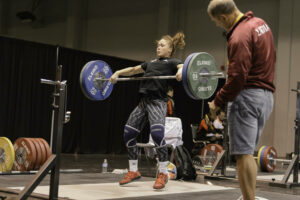
Strength Sensei 101
Exercise Order
More insights into the pioneering training methods of Charles R. Poliquin
The basic format for designing workouts is to perform the exercises that work the biggest muscles first, progressively moving down to the smaller muscle groups. It’s often not that simple, especially when working with higher-level athletes.
First, exercises that are complex from a neurological standpoint, such as weightlifting exercises (snatches, clean and jerks, and their variations) should not be performed in a state of fatigue. You need to be mentally sharp to perform these exercises, and other than exercises that serve as a warm-up (such as an overhead squat), should not be preceded by other exercises that create fatigue.
Weightlifters might start a workout with snatches (fastest lift), followed by snatch pulls (slower lift), then back squats (slowest lift). This pattern would continue, even with multiple training sessions a day, which were necessary to maintain a high quality of training. [Spassov, A., Constructing Training Programs, Part II. National Strength and Conditioning Journal, Vol. 10, No. 5, 1988, pp 65-70; Miller, C., Olympic Lifting Training Manual, 1977, Iron Man Publishing Company, Alliance.] For example, a twice-a-day workout might be designed as follows:
Morning
- Power Snatch
- Split Jerk from Racks
Afternoon
- Snatch
- Clean and Jerk
- Back Squat
Consider that with such workouts, the first exercise may serve as a warm-up for the second, and the second for the third. As such, fewer warm-up sets are needed for the second and third exercises. For example, in the first workout the power snatch warms up the shoulders for the jerks, and in the second workout the clean and jerk warms up the legs for the back squat.
 High-velocity exercises such as the snatch are usually performed before squats, but there are exceptions. (Photo by Linda Brothers, LiftingLife.com)
High-velocity exercises such as the snatch are usually performed before squats, but there are exceptions. (Photo by Linda Brothers, LiftingLife.com)
For advanced trainees, low-velocity exercises can serve as a warm-up for high-velocity exercises if the volume is low. For example, performing 1-2 sets of back squats at 85 percent intensity before snatching. Here is an example:
Morning
- Front Squat
- Power Snatch
- Split Jerk from Racks
Afternoon
- Snatch
- Snatch Pulls
- Back Squat
While program design for the sport of weightlifting has been extensively studied, most trainees will not perform these exercises in their training. However, the Strength Sensei believed it was important to look at muscle fiber type and training goals when determining exercise order.
The Strength Sensei believed that predominately fast-twitch muscles should be trained before predominately slow-twitch muscles. The fast-twitch fibers are more powerful than the slow-twitch fibers but have less endurance than slow-twitch fibers. Fast-twitch fibers are best trained early in a workout when the nervous system is in a non-fatigued state. Thus, the hamstrings should be trained before the quads, and the gastrocnemius should be trained before the soleus. [Sale, D.G. Neural Adaptations to Resistance Training. Medicine and Science in Sports and Exercise. 1988, 20(5), pp S135-S145.]
Regarding aerobic exercise, the Strength Sensei believed that if this type of training must be performed, it should be done after resistance training (or, even more preferably, on an off-lifting day).
To develop maximum strength, you do not want to fatigue smaller muscles that would interfere with the ability to perform exercises for the larger muscles. You would not perform rope pressdowns before performing the bench press unless your primary goal was to develop your triceps (pre-exhaustion method). For bodybuilding, in a presentation he made for the Canadian Olympic Association over three decades ago, this is a guideline the Strength Sensei suggested for exercise order:
- Hips and Thighs
- Back
- Chest
- Shoulders
- Calves and Ankles
- Upper Arms
- Abdomen
- Forearms and Wrists
Finally, there was one rule that took precedence over all others: Train the muscles or exercises you want to emphasize most in a workout early in the training session. Achieving optimal strength levels among all muscle groups was a priority in the Strength Sensei’s training, so this often meant breaking the rules. For example, when he began training powerlifter Cathy Millen, he determined that the weakest link in her bench press was her rotator cuff muscles. He would often have her perform special exercises for the rotator cuff muscles before bench presses. Incidentally, Millen broke world records in the bench press and established herself as a powerlifting legend by breaking a total of 11 world records in three bodyweight divisions.
Putting it all together, here is a workout the Strength Sensei wrote in the 90s for a high school quarterback with his original notes.
High School Quarterback
3-Week Accumulation Phase
Week Reps Sets Tempo Rest
Upper Arm
A1. 30-Degree, Sideways External Rotation on Low Pulley
- 12-15 3 2020 60 seconds
- 12-15 3 2020 60 seconds
- 12-15 3 2020 60 seconds
Notes: Concentrate on rotary shoulder action
A2. Bent-Over Front Raise
- 12-15 3 30X0 60 seconds
- 12-15 3 30X0 60 seconds
- 12-15 3 30X0 60 seconds
Notes: Keep dumbbell in line with ear
B1. Seated Incline Curls
- 10-12 3 3010 90 seconds
- 9-11 3 3010 90 seconds
- 8-10 3 3010 90 seconds
Notes: Keep wrists cocked back, keep upper arms as perpendicular as possible
B2. Lying Dumbbell Triceps Extension
- 10-12 3 3010 90 seconds
- 9-11 3 3010 90 seconds
- 8-10 3 3010 90 seconds
Notes: Use a semi-supinated grip
C1. Standing, Mid-Grip EZ Bar Reverse Curl
- 10-12 3 3210 90 seconds
- 9-11 3 3210 90 seconds
- 8-10 3 3210 90 seconds
Notes: Keep wrists neutral, shoulder-width grip
C2. Varied-Grip Triceps Pressdown, Pronated
- 10-12 3 3210 90 seconds
- 9-11 3 3210 90 seconds
- 8-10 3 3210 90 seconds
Notes: One set narrow, one set medium, one set wide
Week Reps Sets Tempo Rest
Legs
A1. Low Pulley, Sit-Fit Split Squat
- 6-8 4 3010 120 seconds
- 6-8 4 3010 120 seconds
- 6-8 4 3010 120 seconds
Notes: Handle is in contra-lateral hand
A2. Lying Leg Curl, Neutral, Dorsiflexed
- 8-10 4 4010 75 seconds
- 8-10 4 4010 75 seconds
- 8-10 4 4010 75 seconds
Notes: Foot flexed toward the body
B1. Dumbbell Side Step-up
- 70 sec 5 1010 120 seconds
- 70 sec 5 1010 120 seconds
- 70 sec 5 1010 120 seconds
Notes: Make sure that the knee stays slightly outward
B2. Seated Good Morning
- 12-15 4 2110 60 seconds
- 12-15 4 2110 60 seconds
- 12-15 4 2110 60 seconds
Notes: Wide grip on the bar, chest sticking out
- One-Leg Calf Raise
- 12-15 4 1411 60 seconds
- 12-15 4 1411 60 seconds
- 12-15 4 1411 60 seconds
Stretch calves full in the bottom position
Week Reps Sets Tempo Rest
Torso
A1. 1 & ¼ Seated Dumbbell Press
- 8-12 3 3020 90 seconds
- 8-12 3 3020 90 seconds
- 8-12 3 3020 90 seconds
Notes: Quarter rep is at bottom
A2. Leaning Back, Close Parallel Grip, Pulldown to Chest
- 4-6 3 5050 120 seconds
- 4-6 3 5050 120 seconds
- 4-6 3 5050 120 seconds
Notes: Lean back 45 degrees and pull the bar down
B1. Bent-over Barbell Row, Supinated Grip
- 10-12 3 3020 90 seconds
- 9-11 4 3020 90 seconds
- 8-10 4 3020 90 seconds
Notes: Bring the bar to lower waist
B2. Incline Dumbbell Press on Swiss Ball
- 10-12 3 3020 90 seconds
- 9-11 4 3020 90 seconds
- 8-10 4 3020 90 seconds
Notes: Maximize the stretch
C1. Dumbbell External Rotation, Arm in Front
- 10-15 3 2010 0 seconds
- 10-15 3 2010 0 seconds
- 10-15 3 2010 0 seconds
Notes: Make sure to stretch the external rotators, arm in front of you
C2. One-Arm Dumbbell Shrug
- 10-15 3 2010 0 seconds
- 10-15 3 2010 0 seconds
- 10-15 3 2010 0 seconds
Notes: The other arm is extended for support
Although Charles R. Poliquin presented all these training ideas over 30 years ago in various publications, they are still relevant today. As Peter Allen said in his award-winning song from the Oscar-winning musical All That Jazz, “Don’t throw the past away…’cause everything old is new again!” (TSS)
